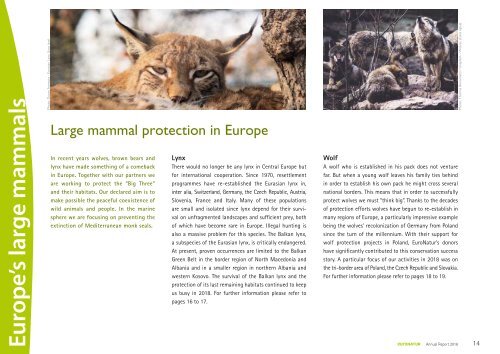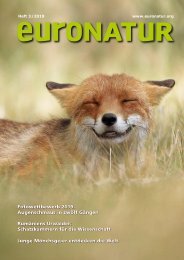Annual Report 2018 EuroNatur Foundation
Here you can get a good overview about our conservation programmes in Europe. Conatains also financial information.
Here you can get a good overview about our conservation programmes in Europe. Conatains also financial information.
You also want an ePaper? Increase the reach of your titles
YUMPU automatically turns print PDFs into web optimized ePapers that Google loves.
Europe’s large mammals<br />
Photo: Dusan Smetana - Eurasian Lynx (Lynx lynx)<br />
Large mammal protection in Europe<br />
In recent years wolves, brown bears and<br />
lynx have made something of a comeback<br />
in Europe. Together with our partners we<br />
are working to protect the “Big Three”<br />
and their habitats. Our declared aim is to<br />
make possible the peaceful coexistence of<br />
wild animals and people. In the marine<br />
sphere we are focusing on preventing the<br />
extinction of Mediterranean monk seals.<br />
Lynx<br />
There would no longer be any lynx in Central Europe but<br />
for international cooperation. Since 1970, resettlement<br />
programmes have re-established the Eurasian lynx in,<br />
inter alia, Switzerland, Germany, the Czech Republic, Austria,<br />
Slovenia, France and Italy. Many of these populations<br />
are small and isolated since lynx depend for their survival<br />
on unfragmented landscapes and sufficient prey, both<br />
of which have become rare in Europe. Illegal hunting is<br />
also a massive problem for this species. The Balkan lynx,<br />
a subspecies of the Eurasian lynx, is critically endangered.<br />
At present, proven occurrences are limited to the Balkan<br />
Green Belt in the border region of North Macedonia and<br />
Albania and in a smaller region in northern Albania and<br />
western Kosovo. The survival of the Balkan lynx and the<br />
protection of its last remaining habitats continued to keep<br />
us busy in <strong>2018</strong>. For further information please refer to<br />
pages 16 to 17.<br />
Wolf<br />
A wolf who is established in his pack does not venture<br />
far. But when a young wolf leaves his family ties behind<br />
in order to establish his own pack he might cross several<br />
national borders. This means that in order to successfully<br />
protect wolves we must “think big”. Thanks to the decades<br />
of protection efforts wolves have begun to re-establish in<br />
many regions of Europe, a particularly impressive example<br />
being the wolves’ recolonization of Germany from Poland<br />
since the turn of the millennium. With their support for<br />
wolf protection projects in Poland, <strong>EuroNatur</strong>’s donors<br />
have significantly contributed to this conservation success<br />
story. A particular focus of our activities in <strong>2018</strong> was on<br />
the tri-border area of Poland, the Czech Republic and Slovakia.<br />
For further information please refer to pages 18 to 19.<br />
<strong>Annual</strong> <strong>Report</strong> <strong>2018</strong><br />
Photo: Thomas Bonometti / Unsplash - Wolves (Canis lupus)<br />
20<br />
14





